Device for self-determination position of a robot
- Summary
- Abstract
- Description
- Claims
- Application Information
AI Technical Summary
Benefits of technology
Problems solved by technology
Method used
Image
Examples
embodiment 1
[0028]FIG. 1 is a front plan view of the present invention of Embodiment 1. The two opposed sides of the rolling wheel 14 have symmetrical configurations, thus only left side is illustrated for detailed description.
[0029] Referring to FIG. 1, FIG. 2 and FIG. 3, the left side of the device includes driving wheel 2, driven wheel 7, decelerator 4 and motor 6 in the sequence from outside to inside.
[0030] The driving wheel 2 is fixed to the wheel shaft 3. The wheel shaft 3 is connected to the power output portion of the decelerator 4. The power input portion of the decelerator 4 is connected to the outputting shaft of the motor 6. Thus the motor 6 drives the wheel shaft 3 to rotate and further causes the driving wheel 2 to rotate as well.
[0031] The driven wheel 7 is rotatably arranged on the wheel shaft 3 of the driving wheel 2 by a bearing 8 and is also fixed between the projecting part and the shaft sheath 13. The driven wheel 7 is arranged coaxially with the driving wheel 2 and the...
embodiment 2
[0034]FIG. 7 is a front plan view of the present invention of Embodiment 2. The configuration of the device in Embodiment 2 is the same with that in Embodiment 1 except for that the arrangement sequence of components on two sides of the rolling wheel 14 in Embodiment 2 is reverse to the arrangement sequence of components in Embodiment 1. Taking the left side of the device as an example, the left side of the device includes a motor 6, a decelerator 4, driven wheels 7 and driving wheels 2 in the sequence from outside to inside.
embodiment 3
[0035]FIG. 8 is a bottom plan view of the present invention of Embodiment 3. The two opposed sides of the rolling wheel 14 have symmetrical configurations, thus only left side is illustrated for detailed description.
[0036] Referring FIG. 8, the front portion of the left side of the device is provided with a driven wheel means and the rear portion is provided with a driving wheel means. The rear portion includes a driving wheel 2, a decelerator 4 and a motor 6 in the sequence from outside to inside. The driving wheel 2 is fixed to the wheel shaft 3, which drives the driving wheel 2 to rotate as the wheel shaft 3 rotates. The decelerator 4 is arranged immediately adjacent to the driving wheel 2 and is connected to the wheel shaft 3. The motor 6 is connected to the power input portion of the decelerator 4 through the outputting shaft.
[0037] The driven wheel 7, having a same diameter with that of driving wheel 2, is arranged on the robot body 1 and moves as the robot body 1 moves, its...
PUM
 Login to View More
Login to View More Abstract
Description
Claims
Application Information
 Login to View More
Login to View More - R&D
- Intellectual Property
- Life Sciences
- Materials
- Tech Scout
- Unparalleled Data Quality
- Higher Quality Content
- 60% Fewer Hallucinations
Browse by: Latest US Patents, China's latest patents, Technical Efficacy Thesaurus, Application Domain, Technology Topic, Popular Technical Reports.
© 2025 PatSnap. All rights reserved.Legal|Privacy policy|Modern Slavery Act Transparency Statement|Sitemap|About US| Contact US: help@patsnap.com



